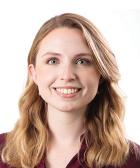Victoria DiTomasso
Fall
2022
Alumni Spotlight
Victoria DiTomasso
BA in Physics, CUNY Macaulay Honors College, Hunter College
and MA in Astronomy, Harvard University
 What she does
What she does
I'm a PhD candidate at Harvard University and work at the Center for Astrophysics | Harvard & Smithsonian, which is a collaboration between Harvard Astronomy and the Smithsonian Astrophysical Observatory.
In my research I search for exoplanets and measure their masses. Today, most exoplanets are discovered using the transit method, which involves monitoring a star’s brightness over time and looking for periodic dimming. This dimming is caused by an exoplanet passing in front of the star, blocking some of its light, and effectively casting a shadow on our telescopes. My research uses the radial velocity method to confirm such detections and measure exoplanet masses. We always say that planets orbit around their stars, but really stars and planets orbit around their shared center of mass, which is slightly offset from the center of the star. This means that a planet induces a small wobble in the movement of the star it orbits. We can measure the movement, or more specifically, the radial velocity, of a star over time and look for this wobble. From this we can determine the gravitational effect of the planet orbiting around that star and measure the planet’s mass.
Currently, I’m finishing a project in which I confirm another team’s detection of a planet around one of the stars in a binary system. Radial velocity measurements require data that has been collected over long periods of time, sometimes many years. Because of this, astronomers often collaborate on gathering data. Right now there are just a few collaborations around the world doing the high-precision radial velocity work needed to find planets in the size range I study—larger than Earth but smaller than Neptune.
My first paper was recently accepted for publication, and I am working on my PhD thesis. I’m also active in science outreach. For example, I made a video about my research for Virtual Scientist in a Classroom, a program through the Harvard Museum of Natural History that’s aimed at a middle school audience. So far I’ve participated in more than five virtual Q&A sessions with middle school classes.
How she got there
I first became interested in physics, and in science, during my junior year of high school. I had a summer internship at the American Museum of Natural History (AMNH), during which I did hands-on activities and demonstrations for visitors and summer camps in the museum halls. I really enjoyed that experience. As part of the program we were introduced to a lot of museum scientists. I realized that doing science—and science education—is a job, and I started thinking about studying physics in college. I thought education and teaching were the main science careers, so when I started college, I wanted to be a high school physics teacher or work at a museum.
During my freshman year at the City University of New York (CUNY) Hunter College, I learned about an astronomy research fellowship called AstroCom NYC, a collaboration between CUNY and AMNH. I had never thought about space before. In fact, I like to joke that growing up in New York, I never saw the stars. I loved the museum and pictured myself being a lifer there. This fellowship was a great opportunity to stay involved at AMNH, and that’s how I started doing astronomy research. Later, as an SPS intern, I was exposed to even more science-related fields.
Best part of her job
Prepandemic, my favorite thing about research was travel. Going to conferences and observatories, working with collaborators, attending workshops—all those things are amazing. I also like the variety of things that I'm doing: research, coding, writing, and reading papers. Then there’s teaching and taking classes and doing outreach. I really love being involved in so many different tasks.
Most challenging part of her job
The flip side of having so much variety—and a lot of freedom to change projects—is the number of times that I encounter steep learning curves. As an undergrad and grad student, I’ve changed my research focus a few times, just to explore, to find out what I like best. At times I feel like I’m starting from zero, but I’m developing additional skills and expertise and building my network, which will benefit me in the long run.
Advice to physics students
Try to focus on what interests and excites you, whether that’s research, outreach, or industry, and make note of situations that aren't exciting or energizing so you know what to avoid in the future. You may not start out with a lot of control over your research topics or colleagues, but knowing what you like and don’t can be helpful later, when you have more choices.
Also, be cautious of putting things off until certain milestones have passed. As an undergrad I would say to myself, “Okay, this is finals week—I’m not going to take care of myself or do anything fun until it’s over.” It can be easy to fall into that kind of thinking, but there is always going to be another milestone. Don’t put off your happiness until X, because you may get caught in a cycle and never get there.
